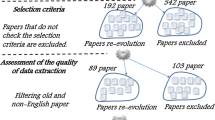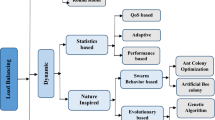Abstract
Ensuring optimal load balancing is imperative for maintaining reliability and upholding quality of service as specified in service-level agreements (SLAs) for cloud computing providers. This research addresses the most common shortcomings of existing state-of-the-art methods, which often lack responsiveness and struggle to adapt to exponentially increasing demand, especially in the era of the internet of things (IoT). The proposed hybrid approach surpasses current literature approaches in performance metrics such as makespan, response time, number of cloudlet migrations, and SLA violations. It operates on two levels, initially employing a k-means clustering algorithm to group servers within each datacenter based on similar utilization rates. Subsequently, a round-robin method allocates task groups sequentially to non-overloaded clusters, and within each cluster, a genetic algorithm optimally assigns tasks to servers. This multilayered approach facilitates hot-deployment and scalability in operational cloud environments while promoting strong interoperability and decoupling of core mechanisms missions. Simulation experiments conducted on CloudSim Plus validate the superiority of our method, positioning it as a robust solution for enhancing load balancing and tasks scheduling in cloud environments, especially in the face of rapidly increasing IoT-related demands.



















Similar content being viewed by others
Data availability
This declaration is not applicable since we have not used any external resource or dataset.
References
Gopala M, Sriram K (2022) Edge computing vs. cloud computing: an overview of big data challenges and opportunities for large enterprises
Kavitha T, Hemalatha S, Saravanan T, Singh AK, Alam MI, Warshi S (2022) Survey on cloud computing security and scheduling. 1–4
Alazzam H, Mardini W, Alsmady A, Enizat A (2019) Load balancing in cloud computing using water flow-like algorithm. In: ACM International Conference Proceeding Series
Tawfeeg TM, Yousif A, Hassan A, Alqhtani SM, Hamza R, Bashir MB, Ali A (2022) Cloud dynamic load balancing and reactive fault tolerance techniques: a systematic literature review (SLR). IEEE Access 10:71853–71873
Kumar P, Kumar R (2019) Issues and challenges of load balancing techniques in cloud computing: a survey. ACM Comput Surv 51
Souravlas S, Anastasiadou SD, Tantalaki N, Katsavounis S (2022) A fair, dynamic load balanced task distribution strategy for heterogeneous cloud platforms based on Markov process modeling. IEEE Access 10:26149–26162
Kashikolaei SMG, Hosseinabadi AAR, Saemi B, Shareh MB, Sangaiah AK, Bian GB (2020) An enhancement of task scheduling in cloud computing based on imperialist competitive algorithm and firefly algorithm. J Supercomput 76:6302–6329
Qaisar F, Shahab H, Iqbal M, Sargana H, Aqeel M, Qayyum M (2023) Recent trends in cloud computing and IoT platforms for it management and development: a review. Pak J Eng Technol 6:98–105
Hong J, Dreibholz T, Schenkel JA, Hu JA (2019) An overview of multi-cloud computing. 1055–1068
Kumar M, Sharma SC, Goel A, Singh SP (2019) A comprehensive survey for scheduling techniques in cloud computing. J Netw Comput Appl 143:1–33
Rehman AU, Aguiar RL, Barraca JP (2022) Fault-tolerance in the scope of cloud computing. IEEE Access 10:63422–63441
Deepa T, Cheelu DD (2017) A comparative study of static and dynamic load balancing algorithms in cloud computing. In: Proceedings of International Conference on Energy, Communication, Data Analytics and Soft Computing (ICECDS-2017)
Kokilavani T, Amalarethinam DIG (2011) Load balanced min–min algorithm for static meta-task scheduling in grid computing. Int J Comput Appl 20:975–8887
Liu G, Li J, Xu J (2012) An improved min-min algorithm in cloud computing. AISC 191:47–52
Miao Z, Yong P, Mei Y, Quanjun Y, Xu X (2021) A discrete pso-based static load balancing algorithm for distributed simulations in a cloud environment. Future Gener Comput Syst 115:497–516
Arulkumar V, Bhalaji N (2021) Performance analysis of nature inspired load balancing algorithm in cloud environment. J Ambient Intell Hum Comput 12:3735–3742
Milan ST, Rajabion L, Ranjbar H, Navimipour NJ (2019) Nature inspired meta-heuristic algorithms for solving the load-balancing problem in cloud environments. Comput Oper Res 110:159–187
Babu KRR, Samuel P (2016) Enhanced bee colony algorithm for efficient load balancing and scheduling in cloud, vol 424. Springer, Berlin, pp 67–78
Adhikari M, Nandy S, Amgoth T (2019) Meta heuristic-based task deployment mechanism for load balancing in IAAS cloud. J Netw Comput Appl 128:64–77
Shafiq DA, Jhanjhi NZ, Abdullah A, Alzain MA (2021) A load balancing algorithm for the data centres to optimize cloud computing applications. IEEE Access 9:41731–41744
Vanitha M, Marikkannu P (2017) Effective resource utilization in cloud environment through a dynamic well-organized load balancing algorithm for virtual machines. Comput Electric Eng 57:199–208
Kumar M, Sharma SC (2018) Deadline constrained based dynamic load balancing algorithm with elasticity in cloud environment. Comput Electric Eng 69:395–411
Priya V, Kumar CS, Kannan R (2019) Resource scheduling algorithm with load balancing for cloud service provisioning. Appl Soft Comput J 76:416–424
Tong Z, Chen H, Deng X, Li K, Li K (2020) A scheduling scheme in the cloud computing environment using deep q-learning. Inf Sci 512:1170–1191
Jena UK, Das PK, Kabat MR (2022) Hybridization of meta-heuristic algorithm for load balancing in cloud computing environment. J King Saud Univ Comput Inf Sci 34:2332–2342
Gamal M, Rizk R, Mahdi H, Elnaghi BE (2019) Osmotic bio-inspired load balancing algorithm in cloud computing. IEEE Access 7:42735–42744
Ragmani A, Elomri A, Abghour N, Moussaid K, Rida M (2020) Faco: a hybrid fuzzy ant colony optimization algorithm for virtual machine scheduling in high-performance cloud computing. J Ambient Intell Hum Comput 11:3975–3987
Chaudhary D, Kumar B (2019) Cost optimized hybrid genetic-gravitational search algorithm for load scheduling in cloud computing. Appl Soft Comput J 83:10
Satpathy A, Addya SK, Turuk AK, Majhi B, Sahoo G (2018) Crow search based virtual machine placement strategy in cloud data centers with live migration. Comput Electric Eng 69:334–350
Abohamama AS, Alrahmawy MF, Elsoud MA (2018) Improving the dependability of cloud environment for hosting real time applications. Ain Shams Eng J 9:3335–3346
Han H, Bao W, Zhu X, Feng X, Zhou W (2018) Fault-tolerant scheduling for hybrid real-time tasks based on CPB model in cloud. IEEE Access 6:18616–18629
Sun H, Yu H, Fan G, Chen L (2020) Qos-aware task placement with fault-tolerance in the edge-cloud. IEEE Access 8:77987–78003
Chinnathambi S, Santhanam A, Rajarathinam J, Senthilkumar M (2019) Scheduling and checkpointing optimization algorithm for byzantine fault tolerance in cloud clusters. Clust Comput 22:14637–14650
Ghasemi A, Haghighat AT (2020) A multi-objective load balancing algorithm for virtual machine placement in cloud data centers based on machine learning. Computing 102:2049–2072
Xu X, Mo R, Dai F, Lin W, Wan S, Dou W (2020) Dynamic resource provisioning with fault tolerance for data-intensive meteorological workflows in cloud. IEEE Trans Ind Inform 16:6172–6181
Mirjalili S, Mirjalili SM, Lewis A (2014) Grey wolf optimizer. Adv Eng Softw 69:46–61
Goyal T, Singh A, Agrawal A (2012) Cloudsim: simulator for cloud computing infrastructure and modeling. Proc Eng 38:3566–3572
Filho MC, Oliveira RL, Monteiro CC, Inácio PR, Freire MM (2017) Cloudsim plus: A cloud computing simulation framework pursuing software engineering principles for improved modularity, extensibility and correctness. In: Proceedings of the IM 2017–2017 IFIP/IEEE International Symposium on Integrated Network and Service Management
Vasile MA, Pop F, Tutueanu RI, Cristea V, Kołodziej J (2015) Resource-aware hybrid scheduling algorithm in heterogeneous distributed computing. Future Gener Comput Syst 51:61–71
Funding
This work has been sponsored by the General Directorate for Scientific Research and Technological Development, Ministry of Higher Education and Scientific Research DGRSDT, Algeria.
Author information
Authors and Affiliations
Contributions
Each author participated actively in conducting analyses, drafting sections of the manuscript, editing and approving the final, submitted version.
Corresponding author
Ethics declarations
Ethical approval
This declaration is not applicable for the purpose of our work.
Competing interests
The authors have no competing interests as defined by Springer or other interests that might be perceived to influence the results and/or discussion reported in this paper.
Additional information
Publisher's Note
Springer Nature remains neutral with regard to jurisdictional claims in published maps and institutional affiliations.
Rights and permissions
Springer Nature or its licensor (e.g. a society or other partner) holds exclusive rights to this article under a publishing agreement with the author(s) or other rightsholder(s); author self-archiving of the accepted manuscript version of this article is solely governed by the terms of such publishing agreement and applicable law.
About this article
Cite this article
Elsakaan, N., Amroun, K. A novel multi-level hybrid load balancing and tasks scheduling algorithm for cloud computing environment. J Supercomput (2024). https://doi.org/10.1007/s11227-024-05990-5
Accepted:
Published:
DOI: https://doi.org/10.1007/s11227-024-05990-5




